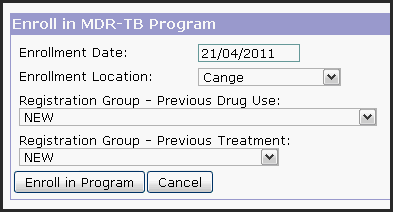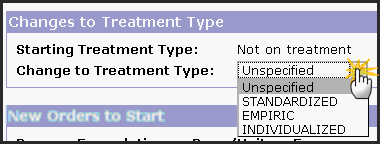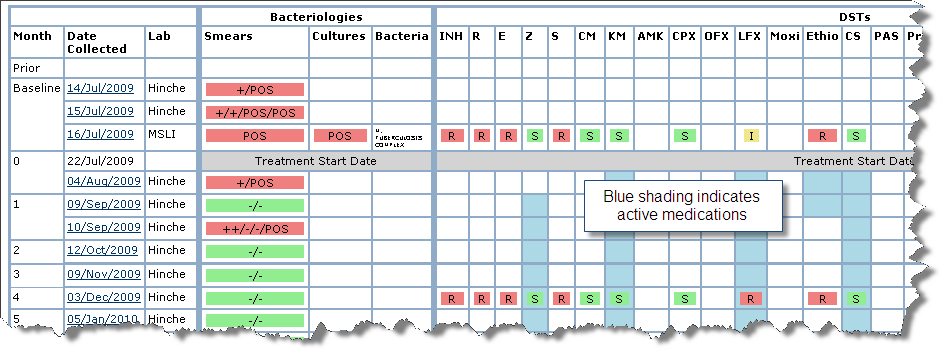General Notes
This User Guide page is divided into two sections, Working with New Patients and Working with Existing Patients. Working with new patients walks through the steps for enrolling a new patient in the MDR-TB program. This includes entering demographic data and baseline clinical data. Working with Existing Patients covers how to view and update a patient's chart.
...
- Specify an enrollment date. The enrollment date should be the same as the patient’s initial encounter
- Specify an enrollment location.
- Specify a registration group according to previous drug use. The registration group should be specified based on the standard WHO definitions. See Appendix for definitions or see original WHO documentation.
- Specify a registration group according to previous treatment. The registration group should be specified based on the standard WHO definitions. See Appendix for definitions or see original WHO documentation.
- Click “Enroll in Program"
...
- Click “Edit Treatment” in the Treatment Status section
- Enter “Tuberculosis Treatment” for Type and enter start date. Click Submit
- Select type of treatment change: Standardized, Empiric, or Individualized.
- See Appendix for definitions or see original WHO documentation.
- See Appendix for definitions or see original WHO documentation.
- Choose a standard regimen OR an individual drug and click Add.
- Enter dose, unit, frequency per day, frequency per week, scheduled stop date, and instructions.
- Click Submit
- From the Treatment tab, click “Overview” to return to that part of the chart.
...
- Click “Close Program” to un-enroll the patient from the active, MDR-TB program. Note, when closing a program we will enter the completion date as well as the outcome. The outcome is determined, in part, by laboratory smear and culture results. Choose the proper outcome based on the standard WHO definitions. See Appendix for definitions
2. Treatment Status
- The Treatment Status section will display every distinct regimen the patient has taken. Based on the start/end dates, the treatment status of “Currently on treatment” or “Currently not on treatment” will display.
- See below for more details on how to edit treatment regimen data.
...
- Resistance Type – The resistance type is calculated automatically based on the patient’s Drug Sensitivity Test results: Confirmed Mono-resistant TB, Confirmed Poly-resistant TB, Confirmed MDR-TB, or Extensive Drug Resistance. See Appendix for definitions or see original WHO documentation.
- Resistance Profile – The resistance profile will list all drugs that the patient tested resistant to at any point during the program.
- Site – This is taken from the documentation of the intake visit.
- Pulmonary – Tuberculosis involving only the lung parenchyma.
- Extrapulmonary – Tuberculosis of organs other than the lungs.
- Diagnostic Smear and Diagnostic Culture – In this section the first smear and culture on record during the program will display.
...
- Lab results are displayed by collection date in ascending chronological order, oldest at the top, most recent at the bottom.
- Active medications are indicated by blue shading.
- DST Results are displayed as:
- S = Susceptible
- I = Intermediate
- R = Resistant
- Waiting for test results
- DST Contaminated
Visits Tab
...






